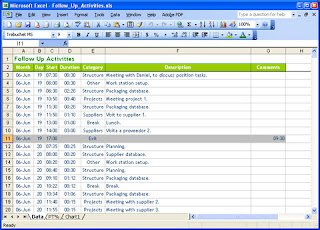 2007 is gone and what an interesting year it was! I learned so much! Writing for this blog has been amazing and it has taught me a lot in itself as well as a lot about myself.
2007 is gone and what an interesting year it was! I learned so much! Writing for this blog has been amazing and it has taught me a lot in itself as well as a lot about myself.It ocurred to me last week that it would be a good idea to list all my past articles so far and add some categories, so that it’ll be a good index of topics. So here goes:
► Business & Management
Designers beware… design is not just about designing.
Designers beware of… customer service.
Getting a client, instead of an occasional buyer.
Designers beware of… filing systems.
Designers beware of… finances.
Designers beware of… production lines.
Designers beware of… technology and supplies.
Designers beware of… time measurement.
Time Tracking Tool.
Designers beware: 10 tips on writing emails.
Designers beware: Setting clear goals and expectations.
Designers beware: 5 steps to productivity, the 5S.
Designers beware: 5S Phase 1, Seiri (Select).
Designers beware: 5S Phase 2, Seiton (Organize).
Designers beware: 5S Phase 3, Seiso (Clean).
Designers beware: 5S Phase 4, Seiketsu (Standardize).
Designers beware: 5S Phase 5, Shitsuke (Improve).
► Recruitment & Selection
Designers beware: 10 tips on designer resumes.
12 resume writing tips for designers.
Designers beware: Being the interviewee (Part 1).
Designers beware: Being the interviewee (Part 2).
Designers beware: Being the interviewer.
Designers beware: Your portfolio.
► Leadership & Self Development
Designers beware of… leadership.
Design leadership and the constant challenges.
Designers beware: Is the design manager or leader the one that is “better” than the rest?
How can I?
Learn English!
Paradigm shifts and design.
Positive feedback.
The 10 Major Causes of Failure in Leadership.
The 11 Major Attributes of Leadership.
Three books you must read before you're 30.
► Creativity & Inspiration
Design magazines.
Design on wheels.
Designers beware: Podcasts.
Designers beware: Travels.
Four Design Influences.
► Resources
Design resources: Coroflot.com.
Design Resources: Design Management Institute, DMI.
Design resources: Springwise.com and Trendwatching.
► Local
10th Design Showroom, Universidad Nacional de Colombia.
Expoartesanías 2007.
Latin American Design Events.
► Reference Articles
Design jobs: 3 great articles.
- Creatives Wanted: How to Prepare Yourself for Today's Job Market.
- Turning Up the Volume: Teleconferencing Etiquette.
- Five Sure Signs Your Job Is a Dead-End.
Design resources: 2 articles.
- Get A Life (And Other Remedies for Creative Atrophy).
- The Proof is in the Process.
► Guest Post
Beginners guide to making money on the internet
► Personal
25 things about me.
Gracias, Merci, Thank you, Danke, Grazie, Obrigada...
I want to thank everybody who visited and commented on my blog! I am sure 2008 will bring more topics to write and discuss about!
All the best!
Special thanks to my friends Wayne Smallman and Carl Grint who have helped me improve this blog.

























